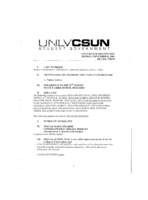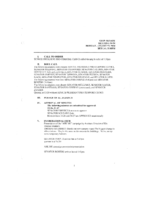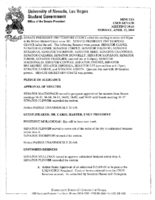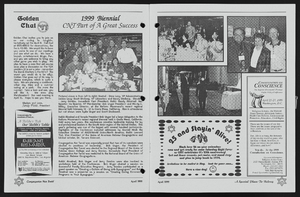Search the Special Collections and Archives Portal
Search Results

Interview with Rosemary Lynch, June 8, 2004
Date
2004-06-08
Archival Collection
Description
Narrator affiliation: Franciscan Sister; Founder, Nevada Desert Experience, Pace e Bene
Text

Interview with Laurie Joe (L. Joe) Deal, September 27, 2005
Date
2005-09-27
Archival Collection
Description
Narrator affiliation: Director, Atomic Energy Commission Civil Effects Group
Text

Interview with Leslie Ray Hill, February 17, 2006
Date
2006-02-17
Archival Collection
Description
Narrator affiliation: Scientist, Sandia National Laboratories
Text

Interview with Cornelius John Smits, July 26, 2005
Date
2005-07-26
Archival Collection
Description
Narrator affiliation: Director, Property Management, Dept. of Energy
Text

Meeting minutes for Consolidated Student Senate, University of Nevada, Las Vegas, November 01, 2004
Date
2004-11-01
Archival Collection
Description
Includes meeting minutes and agenda.
Text

Meeting minutes for Consolidated Student Senate, University of Nevada, Las Vegas, August 23, 2004
Date
2004-08-23
Archival Collection
Description
Includes meeting minutes and agenda, along with additional information about the UNLV Yellowcard concert and the contract for production services at UNLV.
Text

Meeting minutes for Consolidated Student Senate, University of Nevada, Las Vegas, April 12, 2004
Date
2004-04-12
Archival Collection
Description
Includes meeting minutes and agenda.
Text

Meeting minutes for Consolidated Student Senate, University of Nevada, Las Vegas, April 26, 2004
Date
2004-04-26
Archival Collection
Description
Includes meeting minutes and agenda, along with additional information about Rebel Yell Operating Policy, Articles of Incorporation, and the Leadership of Advisory Board.
Text
Pagination
Refine my results
Content Type
Creator or Contributor
Subject
Archival Collection
Digital Project
Resource Type
Year
Material Type
Place
Language
Records Classification


